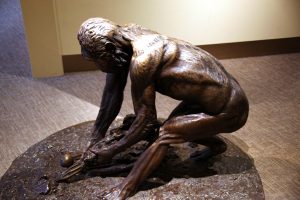 A recent re-examination of the fossils of a species of hominid excavated in South Africa has revealed that they may represent what is popularly known as a “missing link” in human evolution, bridging the gap between the long-extinct genus known as Australopithecus, and the genus modern humans belong to, Homo.
A recent re-examination of the fossils of a species of hominid excavated in South Africa has revealed that they may represent what is popularly known as a “missing link” in human evolution, bridging the gap between the long-extinct genus known as Australopithecus, and the genus modern humans belong to, Homo.
Accidentally discovered in 2008 at South Africa’s Malapa Fossil Site by 9-year-old Matthew Berger, the fossils that would become known as Australopithecus sediba have been dated to be roughly 2 million years old, and represented six individuals: two adults (one male and one female), one juvenile male, and three infants.
This new re-examination, the culmination of 9 different studies made on A. sediba fossils, proposes that Australopithecus sediba is a transitional species, more popularly known as a “missing link”, between the species Australopithecus afarensis–the famed individual known as “Lucy”–and the tool-using “handy man”, Homo habilis. Previously, there had been a 1 million year span of time between Lucy and Handy Man’s existence on Earth, leaving a sizeable gap in what we know about our ancient ancestors’ evolution, but A. sediba may very well help fill that gap.
“This larger picture sheds light on the lifeways of A. sediba and also on a major transition in hominin evolution,” explains lead researcher Scott Williams, of New York University. Australopithecus sediba shares traits that are similar to the skeletons of both the 3-million-year-old Lucy and 2-million-year-old Handy Man, leading the report’s authors to conclude that A. sediba may represent a transition between the two previously-known species.
If this theory is true, A. sediba represents the bridge between not only two individual species, but also link between two different genera altogether, Australopithecus and Homo. In biology, a genus is a group of similar, yet still distinct, species. For instance, Neanderthals, Denisovans and modern humans all belong to the same genus, Homo, while our close cousins chimpanzees and bonobos belong to the genus Pan.
The term “missing link” has fallen out of use amongst biologists, as it implies that evolution follows a linear path, as opposed to the branching nature that is appears to follow. For instance, Neanderthals, as a species, are not the ancestors of modern humans, but rather a sister species that split off from a common ancestor, Homo heidelbergensis, and evolved in parallel alongside early Homo sapiens.
Image Credit:
News Source:
Subscribers, to watch the subscriber version of the video, first log in then click on Dreamland Subscriber-Only Video Podcast link.